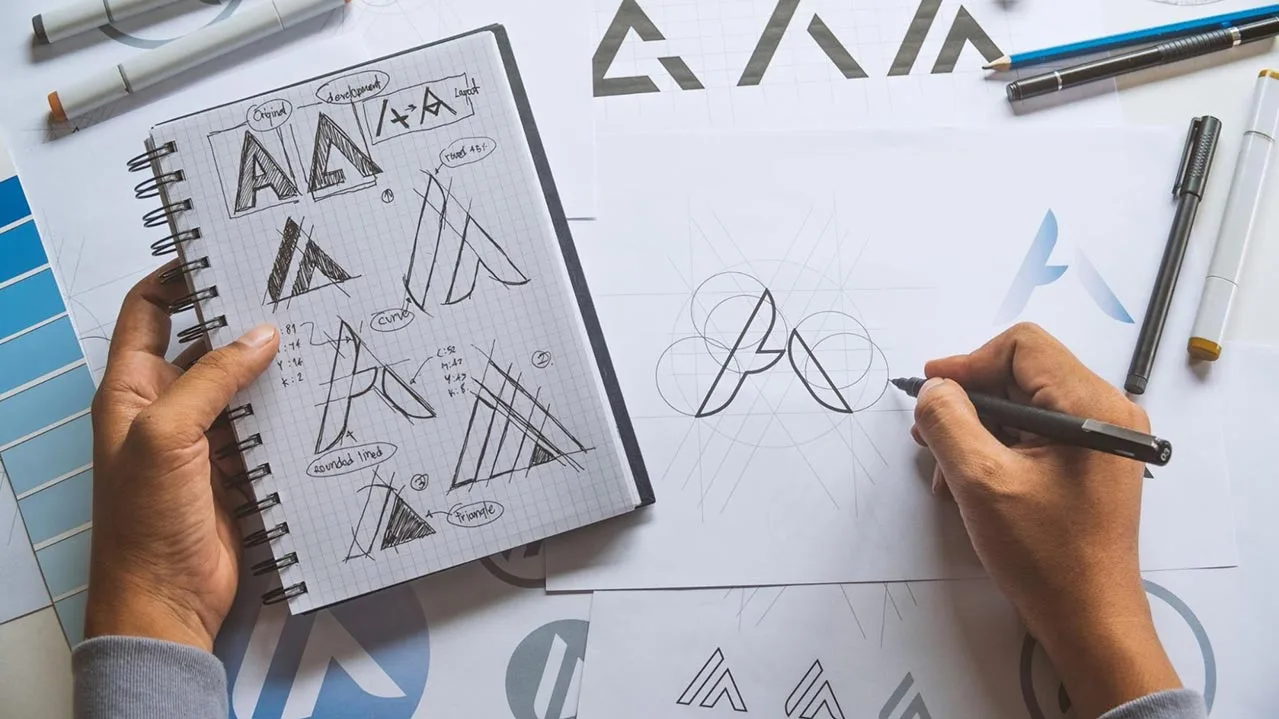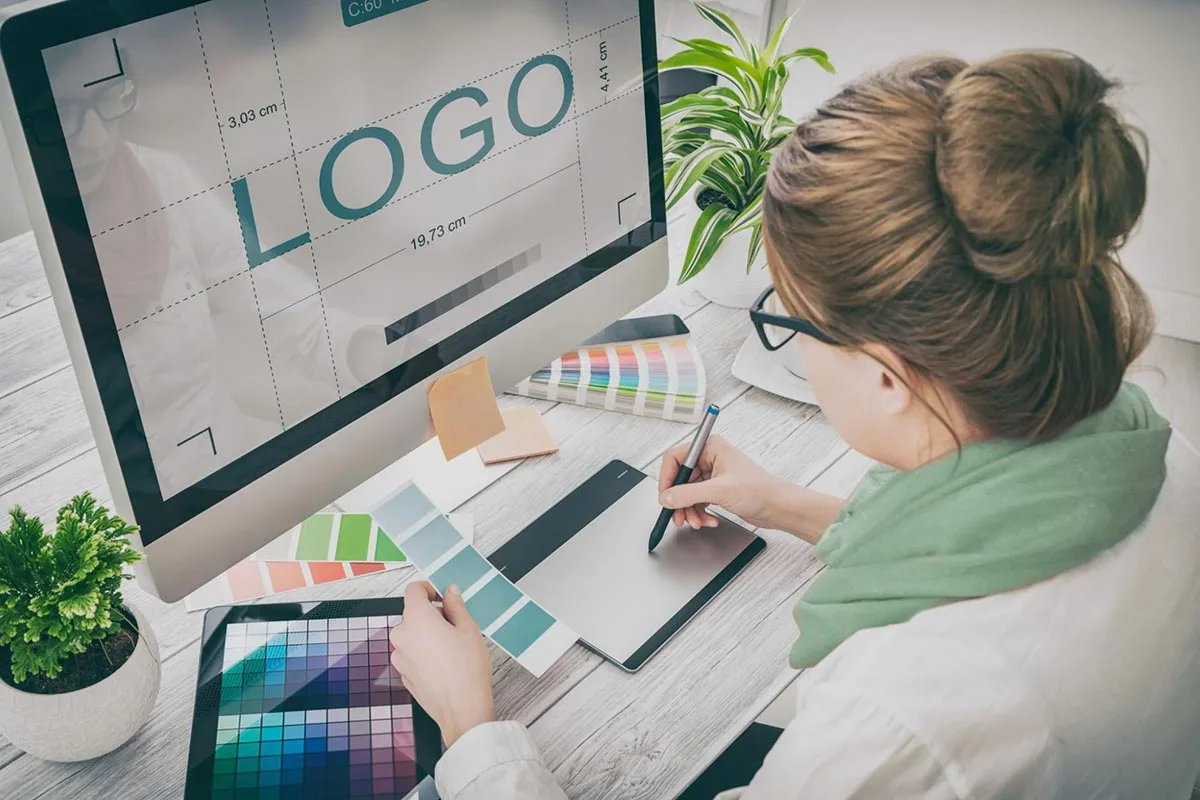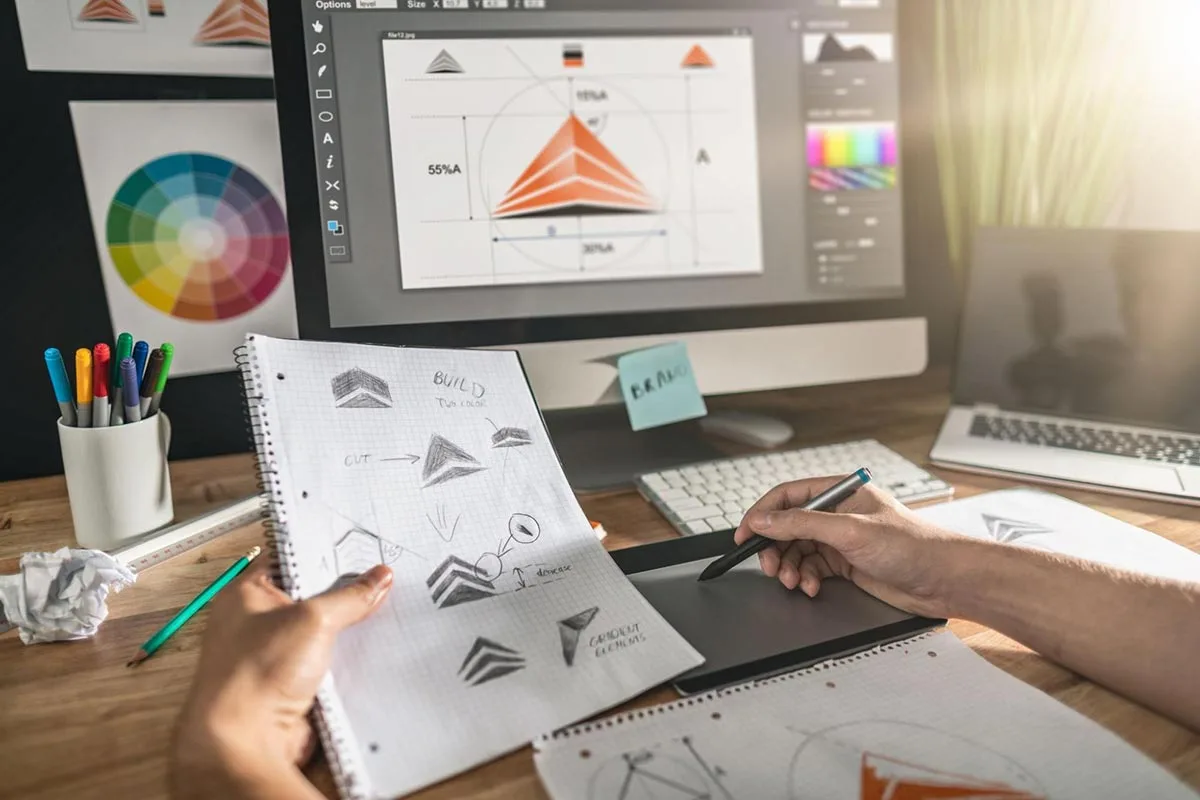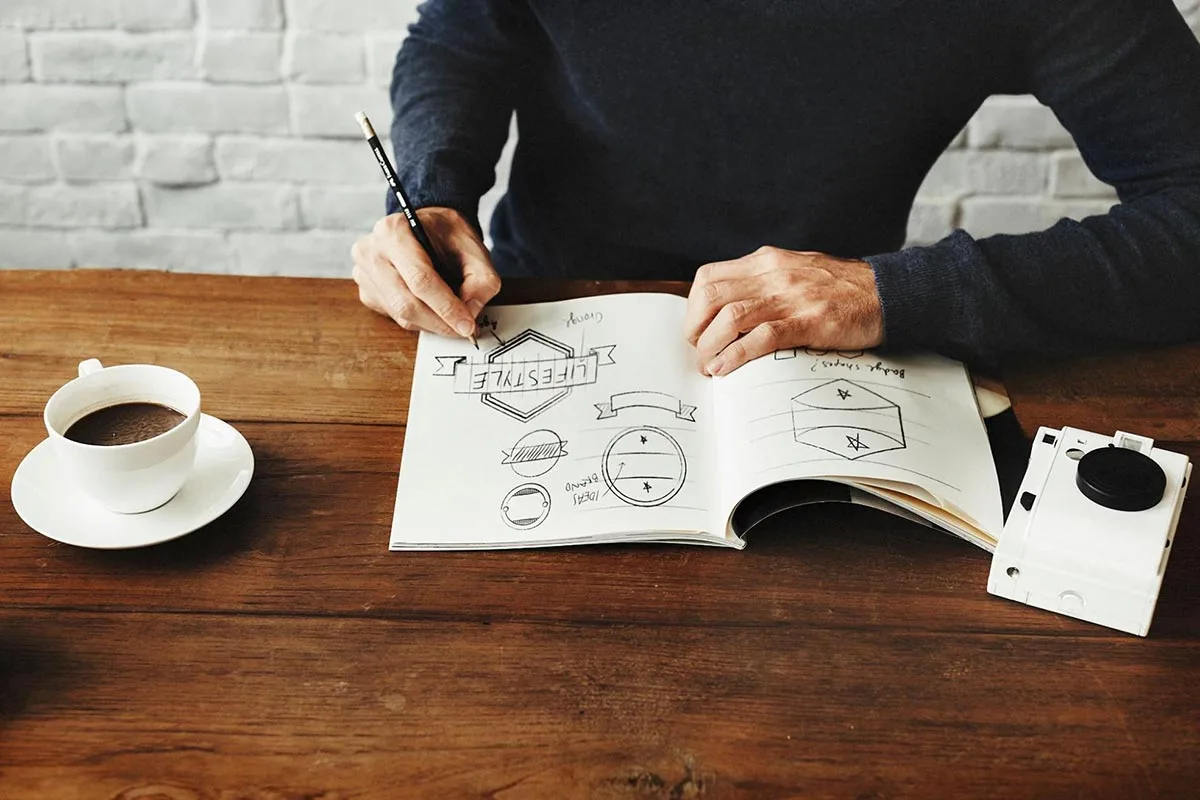How to create a small business logo that stands out
Most small business owners are embracing online marketing as a way to reach more potential customers. In fact, 52% of business owners added or upgraded their website-related services last year, and 54% said they use social media marketing to increase customer engagement. To connect all your digital marketing efforts and make your brand easier to identify online, you need a small business logo.
With a memorable small business logo design, you can help your customers find you, no matter if they’re searching online or driving by your brick-and-mortar location. Here’s everything you need to know about designing a great small business logo, whether you hire a professional, use an artificial intelligence (AI) tool, or do it yourself.

Why do logos matter?
Your logo is a core piece of your visual brand identity. It’s how people spot your business and differentiate you from the competitors.
By using the same logo on your website, your business cards, your online marketing channels, and everywhere else people engage with your business, you create a consistent experience and boost brand recognition. When you pair that with positive customer relationships, just the sight of your logo can evoke a sense of trust and foster loyalty.
Additionally, because many people find it easier to recall images than words, your logo can help past customers recognize your brand even if they’ve forgotten your company name. In countless ways, a custom brand logo plays a big role in helping you grow your small business.
5 elements of a successful logo
There’s no such thing as a perfect logo. Every company is different, and so are their target customers. Successful company logos are designed to attract a specific audience and send a unique brand message. Before you start designing, think about your target audience and what message will best resonate with them.
As a small business owner, here are five critical elements to consider before and during the design process.
1. Brand identity
Your small business logo should be true to your brand’s identity. You want it to tell your story and send your brand message. This is ultimately what will make it a great logo.
As you brainstorm ideas for your company logo, think about what makes you stand out from your competitors and why customers would want to choose you over similar businesses in your area.
Also, take the time to imagine your brand as a person—decide what kind of personality and values your brand would have. Maybe your brand is sincere, wholesome, and honest. Maybe it’s youthful, energetic, and fun. Ultimately, your brand’s personality can inform your font choice, logo colors, and more.
2. Color

The color palette you end up choosing is one of the most impactful elements of a logo.
Most entrepreneurs select two colors for their logos. But you can choose what works best for your brand, whether it’s one color or multiple colors. For example, think of the monochrome Apple logo, which appears in white, black, or gray depending on the background. Alternatively, Google’s four-colored “G” logo takes a mulit-hued approach.
Different colors are known for evoking different feelings. There’s an entire field of research on this called color psychology, which is often used in marketing.
You can use color psychology to make sure your brand is sending the message you want to send. For example:
- Yellow is typically associated with happiness and energy.
- Black and white can represent sophistication, power, or drama.
- Blue evokes a sense of trust and security, so it’s no wonder it’s often used by financial institutions like Chase and American Express.
If you haven’t selected your brand’s color scheme yet, take time to consider which colors match your brand personality. Even the specific shade of a color can make a difference.
Think about how the iconic Tiffany blue made famous by the jeweler feels a lot softer than Facebook’s darker, neutral blue, which is also an accessible color that people who are red-green color blind can see accurately. The choice was inspired by Mark Zuckerberg’s color blindness.
3. Font
Although you don’t have to include your business name in your logo, many companies do—picture the Adidas and Amazon logos as examples.
Many brands also create versions of their logo with their tagline below it. McDonald’s uses a logo like this sometimes. You can find versions of their logo with just the Golden Arches icon, versions with the icon and the brand name, and versions with the tagline “I’m lovin’ it” below the icon.
If you decide to include your brand name in your logo, use your primary brand font. If you don’t have one already, this is an opportunity to choose a font that’s representative of your brand and then to use it throughout your marketing to create a cohesive brand aesthetic. Many companies opt for primary and secondary brand fonts. This allows you to put your logo in a bolder and more noticeable font, with your tagline in a thinner and more subtle font.
Just like colors, typography sends a message about your company. For example, serif fonts like Times New Roman come across as more serious and traditional, while sans serif fonts like Arial feel more modern and creative. Try playing around with different fonts and colors until you find something that feels right for your brand.
4. Simplicity
Simplicity is key when designing a new logo. Not only are minimalist logos a big trend in graphic design, but they’re also a great way to make your logo memorable. Everyone can quickly identify the Nike swoosh or the McDonald’s arches because they’re simple without being too generic.
Even the Starbucks logo—one of the most complex logos from a major brand—has greatly simplified over time, focusing on its most iconic element: the mermaid.
Once you come up with an image that’s representative of your brand, ask yourself if you can make it simpler. Ideally, you want to be able to capture the idea in a two-tone icon, not a full-color illustration.
5. Scalability
A high-quality small business logo design should fit wherever you want to put it. It should be designed to work on a variety of design backgrounds (like signage and banner ads), platforms (like your website and social media channels), and mediums (like T-shirts and mugs) without getting cut off or distorted.
Logos that fit within a square tend to be the most versatile, especially since social media platforms use square or circular profile images. Scalable vector graphic (SVG) files are, as their name suggests, the most scalable option, but high-resolution portable network graphic (PNG) files can also work.
6 types of logos
Now that you understand the five fundamental elements of a good logo, delve into six popular logo styles that can represent your brand. Each of these logo styles are used on a regular basis by both national and small business brands.
Choose the type of logo style you feel most accurately represents your brand’s personality. If you’re unsure, experiment with mockups in a few different logo styles to find the best fit.
1. Wordmark
A wordmark is simply your business name with a font and color scheme that represents your brand. Virgin Airlines, FedEx, and Coca-Cola all use wordmark logos.
The Blonde Salon—a small business in Smyrna, Georgia—also uses a wordmark logo. Their wordmark features a unique layout that emphasizes their brand’s specialty, blonde hair, proving that even a simple wordmark can emphasize your small business’s differentiators.
2. Lettermark
This is similar to a wordmark logo, but instead of including your full business name, you’ll only use your business’ initials. This is most common for brands that are known by their initials, but it can be used by other brands as well. HP, Louis Vuitton, and IBM use lettermark logos.
A&K House Cleaning in Renton, Washington, uses a lettermark logo for their small business. They embrace traditional typography to make their logo look like the monogram you’d find on towels in a traditional-style home, which gives their brand an upscale feel.
3. Pictorial
Pictorial logos feature an icon of a recognizable object. Apple’s logo of an apple with a bite taken out of it is a recognizable pictorial logo. Shell Oil Company’s logo is a seashell graphic. And the Instagram logo is an icon of a camera.
You may choose to create a version of your logo that includes your company’s name next to, above, or under the pictorial.
ProCrew Painting in Eden Prairie, Minnesota, uses a pictorial logo for their small business. It features a recognizable image of a paintbrush painting a rainbow of colors.
4. Abstract

Abstract logos are also graphic icons, but these logos aren’t recognizable objects. They’re typically made up of geometric shapes, and they sometimes represent an abstract concept. For example, the Nike swoosh represents motion. Pepsi, Toyota, and Spotify also use abstract logos.
Broadcast Coffee Bar in Boise, Idaho, is an example of a small business using an abstract logo. They combine a triangle with dots and arched lines to represent the concept of broadcasting in an abstract way.
5. Mascot
Mascot logos have fallen out of favor over the past few decades because they’re complex. These logos feature cartoon characters that often serve as the product’s spokesperson as well. Some well-known mascot logos include Tony the Tiger for Kellogg’s Frosted Flakes, Colonel Sanders for KFC, and the Jolly Green Giant for Green Giant vegetables.
Woof’s Play & Stay in Mission, Kansas, is an example of a small business using a mascot logo. Their cartoon dog logo fits the fun and playful nature of the doggy daycare service they provide.
6. Combination mark
A combination mark combines a graphic with a wordmark, incorporating your company name into your logo’s graphic design. Burger King, Hallmark, and Pizza Hut all use combination mark logos.
Beer City Bicycles—a bike shop and bar in Woodfin, North Carolina—has a combination mark logo that features their business name over an icon of a pint of beer, all encased within a bike chain ring.
Options for your small business logo design
There are three options for creating your small business logo: You can do it yourself, use AI, or hire a professional graphic designer. Each option comes with pros and cons.
DIY logo design

If you don’t have the budget to hire a professional for your small business logo design, you can save money with DIY logo creation. Even if you don’t have design skills, the DIY approach can help you through the ideation process.
To nail down your logo idea, consider your company’s key differentiators, outline your brand personality, and look at what other companies in your industry are doing. Then you can sketch out ideas that represent your brand and will help you stand out. From there, continue to develop the logo yourself by using graphic design tools or a free logo maker tool.
It’s difficult to build a completely unique logo without graphic design skills. For the best results, you should use a vector-friendly program. Vectors can scale to any size without getting blurry or pixelated. Some options for creating a vector graphic include:
You can also use graphic design platforms—like Canva and Adobe Express—that offer free logo design tools. However, with these platforms, you can’t export your final design in a vector format. You’ll have to use a PNG or JPEG. This will likely be sufficient for use on social media or your website when you’re just starting out. But keep in mind that it won’t be as scalable and may not work as well for print.
Something else to keep in mind is that logos created on these platforms typically cannot be trademarked since you’re using logo templates and design elements that are available publicly.
One affordable option for business owners who lack design skills is to brainstorm an idea and then hire a freelance professional designer to finalize the design at an hourly rate. Experienced designers can take a design from sketch to completion in as little as one to two hours at a rate of $60–$150 per hour (the cost varies by experience level and location).
AI logo design
Older online logo makers that used to recycle design elements in random orders to create generic logo designs have now been replaced by something smarter: AI logo creation tools. With AI logo generators, you can provide the AI tool with specific instructions and ask it to create a logo design that’s tailored to your brand.
For example, if you run a coffee shop, you could ask an AI program to give you three combination mark logo designs that incorporate an icon of a coffee bean and include your company’s name. Then you can choose your favorite from the three options or ask it to create more logo options based on additional feedback you provide.
Some AI logo creation tools include:
However, there are downsides to using an AI logo generator.
AI works by emulating what most people are doing. So to create a logo for your coffee shop, AI will look at other coffee shop logos and generate something similar. Therefore it may not be a good option if you want to create something extremely unique and memorable. The trademark laws around AI-generated content are also murky, so you likely won’t be able to trademark your logo in the near future.
Professional logo design
The best, but also the most expensive, way to get a custom logo design is to hire a professional graphic designer. Working with a pro can help you create a memorable logo that’s unique to your brand.
Even if you run a startup with a tight budget, logo design can be affordable. Small business owners usually hire freelance graphic designers to create their logo designs. Freelancers tend to be more affordable than design agencies, which can charge thousands of dollars for logo designs or branding packages.
You can find quality logo designers on freelance sites like Upwork and Fiverr or on business platforms like Yelp. But before you choose a professional, make sure your designer will:
- Give you full ownership rights to the logo: Unless the designer has explicitly transferred the rights to you, they can claim ownership of their creation.
- Provide the final design in multiple high-resolution file formats: This should include vector files, which use precise dots, lines, and curves instead of colored blocks (pixels) and are necessary for retaining quality when printing at any size.
- Send you finalized logos within your desired time frame: Typically, designers require 3–4 weeks to complete a logo from scratch. But each designer will have their own lead times depending on their workload.
Ask for design samples and a consultation before you commit to logo design services. You can also provide your designer a creative brief to ensure you get logo designs that align with your vision.
A creative brief should share any decisions you’ve already made about your branding, including fonts, colors, brand personality, and values. You can also mention the type or types of logos you’re considering. You can give examples of other companies’ logos that you admire. And if you have any ideas for a pictorial icon or a concept that you would like to represent your brand, include that as well.
Your creative brief can be as specific or as broad as you’d like. If you haven’t decided on your fonts and colors, you can work with your designer to create a complete branding package. Your designer can recommend fonts and colors that match your brand values in addition to creating logo options.
What are the average costs of logo creation?
Entry-level designers can provide custom logo designs for as little as $100–$300. At the lower end of the pricing scale, you may get fewer logo options (though typically you’ll get at least two) to choose from. For a more exact price estimate, specify the number of design options you want to receive during your consultation with the designer.
With more experienced designers, you can expect to pay $300–$800 for up to 10 unique logo design options. Revisions are typically included, as long as you’re not asking for a completely new design.
Experience can make a big difference when you want an enticing, versatile logo that stands the test of time. Experienced freelancers can be worth the higher price point, as a logo is a one-time investment that will solidify your branding for decades.
If you’re starting a business from scratch, you can also hire a designer to create a complete branding package. Branding packages include a logo, graphic elements, and a design style guide. They help you establish a consistent look for your company, so that your website, social media accounts, online ads, and more have a cohesive style. Branding packages may cost as little as $1,500 with a freelancer.
Stand out with a stellar small business logo
A great small business logo design is crucial for building a successful brand. When you pay attention to the five key elements of a successful logo—brand identity, color, font, simplicity, and versatility—your logo can create a great first impression and inspire lasting loyalty. For a successful logo, consider outsourcing to a professional designer, especially if you don’t have design skills yourself.
Once you’ve created your logo, explore more branding ideas for small businesses on a budget.